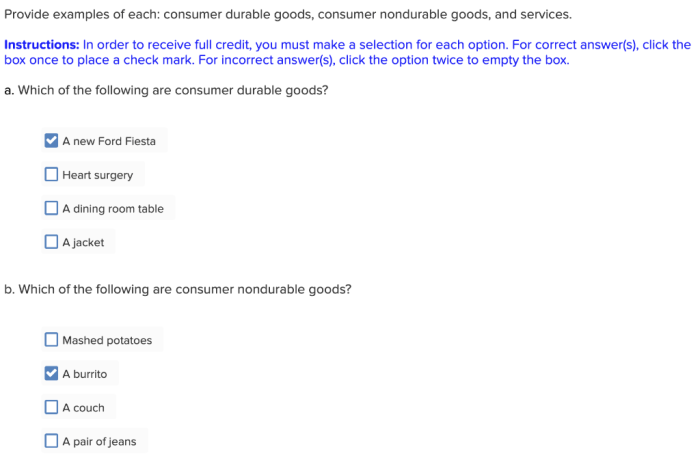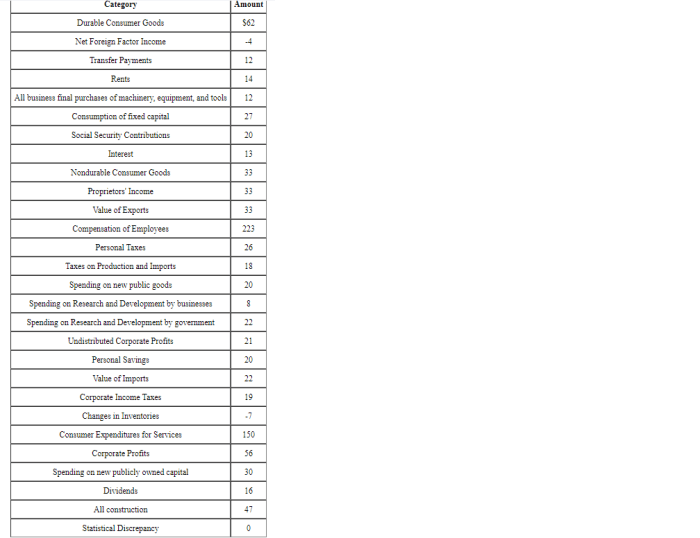The sales of durable and nondurable goods bought by consumers play a pivotal role in shaping economic growth and consumer spending patterns. Understanding the dynamics of this market is crucial for businesses and policymakers alike. This comprehensive analysis delves into the key definitions, consumer behavior, market dynamics, economic impact, marketing strategies, and data analysis related to the sales of durable and nondurable goods, providing valuable insights for stakeholders in the industry.
Definition and Distinction

Durable goods are physical products that are expected to last for at least three years and can withstand repeated use. Examples include appliances, furniture, and vehicles. Nondurable goods, on the other hand, are products that are consumed or used up within a relatively short period, typically less than three years.
Examples include food, beverages, and clothing.
Consumer Behavior and Trends

Consumer behavior patterns for durable goods typically involve careful consideration, research, and long-term planning. Factors influencing purchases include price, quality, durability, and brand reputation. Nondurable goods, on the other hand, are often purchased more frequently and impulsively. Consumers tend to be more price-sensitive and may be influenced by factors such as convenience, taste, and packaging.
Emerging Trends
- Increasing demand for durable goods with energy-efficient and smart features
- Growing popularity of subscription services for nondurable goods (e.g., meal kits, streaming services)
- Shift towards online shopping for both durable and nondurable goods
Market Dynamics and Competition
Key Market Dynamics
- Technological advancements driving innovation and product development
- Economic conditions and consumer confidence impacting demand
- Changing consumer preferences and lifestyle trends
Competitive Landscape
The market for durable and nondurable goods is highly competitive, with numerous established players and emerging challengers. Major players include manufacturers, retailers, and e-commerce giants.
Impact of Technological Advancements
Technological advancements are revolutionizing the market for durable and nondurable goods. Innovations such as smart appliances, wearable devices, and personalized products are transforming consumer experiences and creating new opportunities for market growth.
Economic Impact

The sales of durable and nondurable goods play a significant role in economic growth and consumer spending. Durable goods contribute to capital formation and investment, while nondurable goods stimulate consumption and economic activity.
Macroeconomic Factors
- Economic growth and consumer confidence
- Interest rates and inflation
- Government policies and regulations
Impact of Government Policies, The sales of durable and nondurable goods bought by consumers
Government policies and regulations can impact the market for durable and nondurable goods. For example, tax incentives for energy-efficient appliances or restrictions on single-use plastics can influence consumer behavior and industry practices.
Marketing and Sales Strategies
Effective Strategies for Durable Goods
- Emphasize product durability, quality, and brand reputation
- Provide detailed product information and customer support
- Utilize online and offline channels to reach potential customers
Effective Strategies for Nondurable Goods
- Focus on convenience, affordability, and product variety
- Create memorable advertising campaigns and promotions
- Leverage social media and digital marketing for brand engagement
Role of Digital Marketing
Digital marketing has become increasingly important for the sales of both durable and nondurable goods. Online advertising, social media marketing, and e-commerce platforms offer businesses opportunities to connect with consumers and drive sales.
Data Analysis and Forecasting
Key Metrics and Data Sources
- Sales data from manufacturers, retailers, and e-commerce platforms
- Consumer surveys and market research reports
- Economic indicators and macroeconomic data
Data Analysis and Forecasting Models
Data analysis can help identify sales trends, consumer preferences, and market opportunities. Forecasting models can be developed to predict future sales and inform strategic decision-making.
Challenges and Limitations
- Data availability and reliability
- Rapidly changing consumer behavior and market dynamics
- Economic uncertainty and macroeconomic factors
Questions and Answers: The Sales Of Durable And Nondurable Goods Bought By Consumers
What is the key difference between durable and nondurable goods?
Durable goods are those that can be used repeatedly over an extended period, such as appliances, furniture, and vehicles. Nondurable goods, on the other hand, are those that are consumed quickly or have a short lifespan, such as food, beverages, and clothing.
What factors influence consumer preferences for durable and nondurable goods?
Consumer preferences for durable and nondurable goods are influenced by factors such as income, lifestyle, demographics, and cultural norms. For example, consumers with higher incomes may be more likely to purchase durable goods, while those with lower incomes may prioritize nondurable goods.